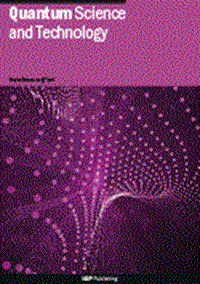费米子观测值的自适应深度随机测量
IF 5
2区 物理与天体物理
Q1 PHYSICS, MULTIDISCIPLINARY
引用次数: 0
摘要
精确估计费米子观测值对于推进量子物理和化学是必不可少的。费米子经典阴影(FCS)方法提供了一个有效的框架来估计这些可观测量,而不需要将k-局部费米子可观测量转换为泡利基。然而,FCS中的随机匹配门电路需要具有砖结构的线性深度电路,这对计算资源有限的近期量子器件提出了重大挑战。为了解决这一限制,我们引入了一种自适应深度费米子经典阴影(ADFCS)协议,旨在减少电路深度,同时保持样本复杂度。通过理论分析和数值拟合,我们建立了当局域k为常数时,近似费米子可观测值H所需的深度上界为,其中dint为H的相互作用距离,n为量子比特数。我们通过数值实验证明了ADFCS协议的有效性,该协议显示出与传统FCS方法相似的精度,而所需的量子资源显着减少。此外,我们应用ADFCS计算了Kitaev链哈密顿量的期望值,进一步验证了其在实际场景中的性能。我们的研究结果表明,当局域k恒定时,ADFCS可以实现更有效的量子模拟,减少电路深度,同时保持样本复杂性,并为近期量子器件提供可行的解决方案。本文章由计算机程序翻译,如有差异,请以英文原文为准。
Adaptive-depth randomized measurement for fermionic observables
Accurate estimation of fermionic observables is essential for advancing quantum physics and chemistry. The fermionic classical shadow (FCS) method offers an efficient framework for estimating these observables without requiring a transformation into a Pauli basis for k-local Fermionic observables. However, the random matchgate circuits in FCS require linear-depth circuits with a brickwork structure, which presents significant challenges for near-term quantum devices with limited computational resources. To address this limitation, we introduce an adaptive-depth fermionic classical shadow (ADFCS) protocol designed to reduce the circuit depth while maintaining the sample complexity. Through theoretical analysis and numerical fitting, we establish that the required depth for approximating a fermionic observable H is upper bounded by when the locality k is a constant, where dint is the interaction distance of H and n is the number of qubits. We demonstrate the effectiveness of the ADFCS protocol through numerical experiments, which show similar accuracy to the traditional FCS method while requiring significantly fewer quantum resources. Additionally, we apply ADFCS to compute the expectation value of the Kitaev chain Hamiltonian, further validating its performance in practical scenarios. Our findings suggest that ADFCS enables more efficient quantum simulations when the locality k is constant, reducing circuit depth while preserving the sample complexity and offering a viable solution for near-term quantum devices.
求助全文
通过发布文献求助,成功后即可免费获取论文全文。
去求助
来源期刊

Quantum Science and Technology
Materials Science-Materials Science (miscellaneous)
CiteScore
11.20
自引率
3.00%
发文量
133
期刊介绍:
Driven by advances in technology and experimental capability, the last decade has seen the emergence of quantum technology: a new praxis for controlling the quantum world. It is now possible to engineer complex, multi-component systems that merge the once distinct fields of quantum optics and condensed matter physics.
Quantum Science and Technology is a new multidisciplinary, electronic-only journal, devoted to publishing research of the highest quality and impact covering theoretical and experimental advances in the fundamental science and application of all quantum-enabled technologies.
 求助内容:
求助内容: 应助结果提醒方式:
应助结果提醒方式:


